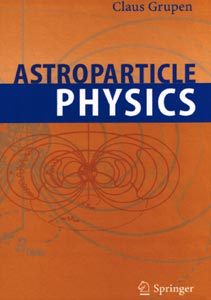by Claus Grupen, Springer. Hardback ISBN 3540253122, €37.40, (£27, $59.95).
Claus Grupen provides a comprehensive and up-to-date introduction to the main ideas and terminology of the study of elementary particles originating from astrophysical objects. In fact, as is evident from the historical introduction, astroparticle physics reaches beyond elementary particles and includes gamma radiation, X-rays, gravitational waves, and extensions of the current Standard Model.

The style and presentation of the material make the book accessible to a broad audience with a basic knowledge of mathematics and physics. A good selection of simple exercises with solutions increases its pedagogical value and makes it suitable as a textbook for an undergraduate course. Non-specialists who want to follow the main issues of current research in the field or to have a general overview before more advanced readings can also benefit from Grupen’s book.
A distinguishing feature of the book is the use of relatively simple models directly tied, where possible, to experimental data; these illustrate physical mechanisms or problems without unnecessary details. The main physical motivations for a theory are introduced, its experimental consequences discussed together with the current status of the key parameters and the expected future developments. Both the pedagogical nature and the emphasis on the experimental basis of models are signalled by a chapter dedicated to particle and radiation detectors and, especially, by the many instructive figures and diagrams that illustrate data and their theoretical interpretations.
A good third of the book deals with cosmic rays, our main experimental window on the universe. Grupen presents the astronomy of neutrinos, gammas and X-rays, and discusses and reviews the basic mechanisms for particle acceleration and production, and important topics such as extended atmospheric showers initiated by the highest-energy cosmic rays or gamma-ray bursts. This part constitutes the foundation of astroparticle physics.
The next largest part of the book, about one quarter, is devoted to the thermal history of the early universe, including an extensive description of Big Bang nucleosynthesis.
Introductions to standard cosmology and to basic statistical mechanics are included. In addition there is a concise description of the important information carried by the cosmic microwave background radiation – in particular, the bearings of the latest measurements of the radiation’s angular anisotropy on key cosmological parameters, such as the total energy density, the baryon-to-photon ratio and the Hubble constant.
Before the stimulating overview of some of the open problems and perspectives of the field the author reserves two chapters for inflation and dark matter. These fundamental concepts in modern astrophysics not only answer specific experimental and theoretical questions (rotational curves of galaxies, monopoles, flatness, etc), but raise new ones and stimulate experimental tests.








